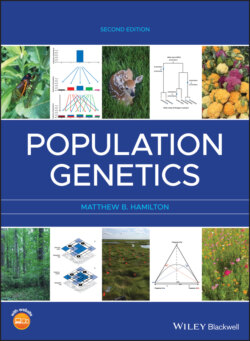Читать книгу Population Genetics - Matthew B. Hamilton - Страница 50
Population size
ОглавлениеIt is possible to observe gametic disequilibrium just by chance in small populations or small samples of gametes. Recombination itself is a random process in terms of where crossing over events occur in the genome. As shown in the Appendix, estimates are more likely to approach their true values as larger samples are taken. This applies to mating patterns and the number of gametes that contribute to surviving progeny in biological populations. If only a few individuals mate (even at random) or only a few gametes found the next generation, then this is a small “sample” of possible gametes that could deviate from independent segregation just by chance. When the chance effects due to population size and recombination are in equilibrium, the effects of population size can be summarized approximately by
(2.40)
where Ne is the genetic effective population size and c is the recombination fraction per generation (Hill and Robertson 1968; Ohta and Kimura 1969a, b; the basis of this type of equation is derived in Chapter 4). As shown in Figure 2.23, when the product of Ne and c is small, chance sampling contributes to maintaining some gametic disequilibrium since only a few gametes contribute to the next generation when Ne is small and genetic drift is strong, or only a few recombinant gametes exist when c is small. The lesson is that D as we have used it in this section assumes a large population size (similar to Hardy–Weinberg) so that actual gamete frequencies approach those expected based on allele frequencies, an assumption that is not met in actual populations to some degree because they are finite. Strong growth in population size over time can also alter the rate of decay of gametic disequilibrium compared to that seen in a population of constant size through time (Pritchard and Przeworski 2001; Rogers 2014).
Figure 2.23 Expected levels of the squared gametic disequilibrium correlation (ρ2) due to the combination of finite effective population size (Ne) and recombination at rate (c). Gametic disequilibrium is greater when fewer recombinant haplotypes are produced each generation (small c), the population is small causing haplotype frequencies to fluctuate by chance (small Ne), or if both factors are acting in combination (small Nec).
